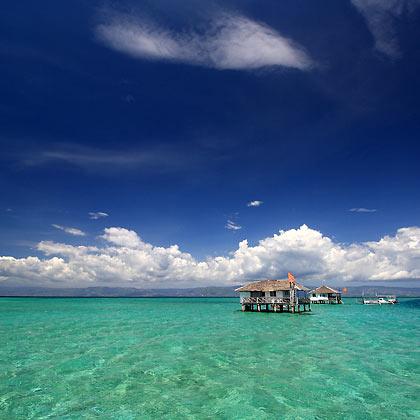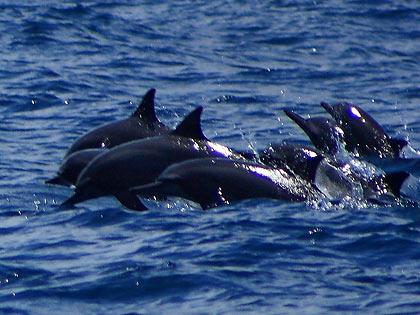 You may also check these sites:
You may also check these sites:
https://www.shoestringtravelers.com/?q=node/109
https://shoestringdiary.wordpress.com/?s=Bais%3A+Dolphins+and+Sandbars
It had been about an hour since we left the Canibol Wharf and still no sight of the dolphins. These marine mammals were supposed to appear within 30-45 minutes after our boat left the wharf but when we saw none we just kept motoring on in the direction of southern Cebu. The spotter on a returning boat was signaling "no dolphins" and pointing to another direction towards which our boat then headed. After another 20 minutes or so of fruitless searching we were beginning to blame ourselves for having started this tour so late in the morning. We turned to our spotter to ask if it was still wise to continue, but before we could utter a word he was shouting and pointing ahead. Sure enough, a pod of dolphins broke the surface in short, smooth jumps, then another. It wasn't long before as many as 20 dolphins were circling or swimming parallel to our boat.
Dolphin Watching
The city of Bais in Negros Oriental has been serving as the base for boatloads of tourists on dolphin and whale-watching tours at the Tañon Strait, the body of water separating Negros Oriental from southern Cebu. Occasionally, a few species of whales, and even whale sharks may be spotted here but the vast majority of sighting are that of spinner dolphins, so named because they spin as they leap out of the water. Spinner dolphins doing shallow glides at the Tañon Strait.
Spinner dolphins doing shallow glides at the Tañon Strait.
The day after our whale shark-watching tour at Oslob in nearby Cebu, we headed out for Bais from Dumaguete City where we had booked a hotel for a few days. At the Canibol Wharf we bargained for a boat that was good for 25 people even though there were only 6 in our group. There were smaller boats that could fit 10-15 people but we decided to take this boat since it had its own rest room plus a grill for barbecuing fresh tuna that we bought at the market in Bais City proper.
Dolphins are best sighted at the Tañon Strait from March to October but the peak months are in April and May. Tour operators encourage visitors to be at Canibol Wharf early since the dolphins are usually sighted from 6 AM to 10 AM only. In our case we arrived really late at almost 10 AM, hence our apprehension. Our patient boatmen kept at it, however, and though it took more than the usual time we were soon enjoying watching dolphins playfully circling our boat.

Many people would like to think that dolphins are friendly to humans and that they seek out human contact. Some particular species of dolphins do tend to seek social encounters with humans. But the idea that those encounters are friendly is ambiguous. These are still wild animals and some have been observed to exhibit aggressive behavior that is not necessarily friendly.

In our case we simply stayed at the boat and watched these mammals perform their acrobatics. We discovered that once we spot a pod of dolphins we can just stay in the area and wait for other pods to show up and circle or swim alongside our boat. It's the dolphins' inquisitive behavior at work. These are spinner dolphins whose name comes from the twisting movement of their bodies as they surge out of the water and rise into the air. In our case however, the dolphins were not leaping as high as we have seen them in pictures and videos. Our boatmen told us that these athletic feats are done by the dolphins early in the morning – around 6AM. (It was almost noontime when we encountered them.)
After more than 30 minutes of witnessing this spectacle we were getting hungry. We decided to bid farewell to the dolphins and head out towards our next destination: the Manjuyod Sandbar. We first spotted the dolphins after a little over an hour's sailing from the wharf – at which point we were actually closer to Cebu than to Negros Island – so it took us nearly an hour to get to this sandbar.

Manjuyod Sandbar
The Manjuyod Sandbar lies in North Bais Bay in the Tañon Strait and could easily be sighted from the Canibol Wharf; it takes a boat only 15 minutes to get there from the wharf. This sandbar is a 7-kilometer stretch of white sand that is often used as a stopover on dolphin-watching tours. We actually passed Manjuyod on the way to our dolphin watching jaunt. Boats may be temporarily moored here while occupants explore the sandbar, swim, snorkel, bum around and/or take their meals. There are also four cottages on stilts that can accommodate guests for overnight stays.
 No white sand but plenty of crystal-clear waters.
No white sand but plenty of crystal-clear waters.
By the time we got to Manjuyod, however, the white sand was fully submerged because of the high tide. The sandbar is only fully exposed at low tide which usually happens during early morning hours. This did not prevent us from enjoying the scenery. Crystal-clear turquoise waters covered the long stretch of the sandbar, forming a striking contrast to the blue skies and low-lying white cumulus clouds. A gentle breeze kept blowing against our boat, almost lulling us to sleep before we could even take lunch.
Lunch! We had gambled on this trip, choosing to buy food at Bais City proper rather than bringing them all the way from Dumaguete and it was a gamble that paid off. The highlight of our lunch was the panga ng tuna or tuna jaw bought fresh from the market at Bais proper and grilled by our boat crew. We would later agree that it tasted even better than the one served at Lab-as Restaurant in Dumaguete (which was already pretty good by the way).
 A peaceful scene that lulled many of us to sleep.
A peaceful scene that lulled many of us to sleep.
After lunch and some rest we tried to explore the waters surrounding Manjuyod but realized that it was more than neck-deep for Leo who ended up snorkeling in the waters instead. This is a sandbar which is usually devoid of corals so we weren't expecting to see a lot of colorful marine life but there were many schools of small fishes in the waters immediately around the boat. After resting some more – some of us even caught a quick nap on the boat – it was time to wrap up our dolphin-watching and sandbar-bumming trip. Soon we were headed back to Canibol Wharf for the trip back to Bais proper and ultimately Dumaguete.
 Two of the huts on stilts at Manjuyod.
Two of the huts on stilts at Manjuyod.
How to Get There and Other Tips
At Dumaguete City take a Ceres Bus Liner at their terminal near Robinson's Place at Brgy. Calindagan. There are Ceres mini buses bound for Bais that can make the trip in an hour or so. We accidentally got on a bus to Bacolod at this terminal – a large air con bus that passes by Bais on the way to Bacolod. It is not as frequent as the mini-buses bound for Bais and in retrospect we might have been served better had we rode a mini-bus that left for Bais much earlier than the Bacolod-bound bus. (Buses with no air conditioning are not a problem outside the big cities as the surrounding air is fresh and clean and the ride is relatively cool even in the summer.)
At Bais town proper get on a trike to either the Capiñahan Wharf (at South Bais Bay) or the Canibol Wharf (at North Bais Bay). Capiñahan Wharf is where the local government-operated boats and the Bais City Tourism office are located while private boats operate from Canibol. In our case we simply asked our trike driver to take us to the dolphin-watching boats and he promptly motored us to Canibol Wharf. Boat prices in both of these wharves can range anywhere from P3,000 to P5,000. The boat referred by the trike driver had a seating capacity of 25 or more. The operator was charging us P5,000 but we managed to haggle it down to P3,500 by dispensing with the usual trip to the Talabong Mangrove Park. The boat had no passengers earlier that morning and was probably only doing its best to get a trip for the day, hence the big discount.
 The interior of our 25-person capacity boat.
The interior of our 25-person capacity boat.
The boats will take you to the middle of the Tañon Strait for dolphin-watching, then bring you to the Manjuyod Sandbar. It is best to be at Canibol Wharf very early in the morning – our boatmen said doing the trip at 6AM will usually guarantee a sighting of spinner dolphins doing their aerial acrobatics, something we failed to see since we arrived in the middle of Tañon Strait at almost 11AM. We were actually fortunate to observe several pods of dolphins; the probability of seeing these mammals after 10AM decreases sharply. Tide-permitting, the boats can also take you to theTalabong Mangrove Park, a 400-hectare protected sanctuary, a trip which we had to forego because of our haggling. You can also ask the boat to stop at certain spots for snorkeling.
Bais City tourism officials encourage dolphin watchers to book ahead of time particularly during the peak months of April and May, something which we did not do but were still fortunate enough to get a boat. The city government boats are available for booking at telephone numbers: 63 (35) 402-8174, 63 (35) 402-8040 and 63 (35) 402-8180. Bais tourism personnel can also assist travelers headed for Capiñahan Wharf and help them buy food supplies at the Bais public market.










